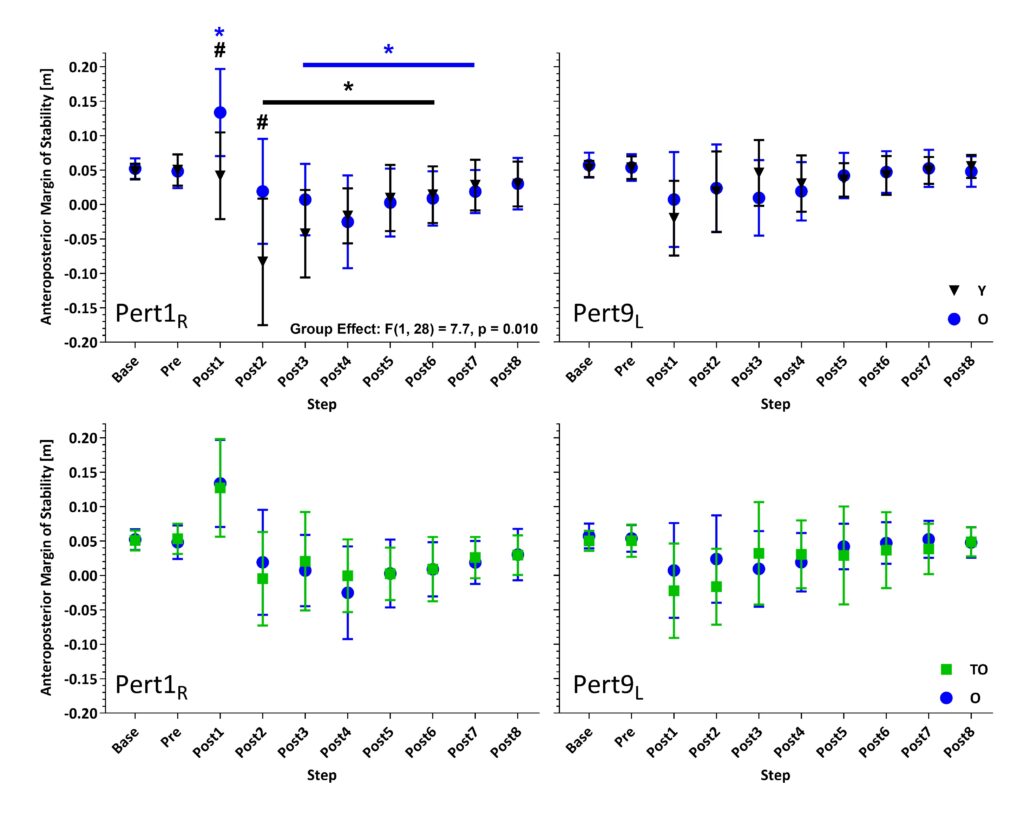By Lotte Grevendonk and Christopher McCrum
There are many benefits of habitual physical activity, exercise and sports participation for older people. However, the extent to which these influence one of the most common causes of injuries in older age, namely falls, is unclear. In this study, we assessed the influence of age on various metabolic and mobility-related outcomes, accounting for physical activity levels. We also evaluated the additional effects of more extensive exercise or sports participation in old age. In this blog post, we focus on our motion-capture derived gait outcomes.
We investigated walking characteristics of 12 younger adults (~24y) versus 13 healthy older adults (~71y) with approximately the same habitual physical activity levels (~10,000 steps per day, 2.6% and 2.2% of waking time in high intensity physical activity). We also compared the same healthy older adults with 15 exercise-trained older adults (~68y, ~14,000 steps per day, 5.3% of waking time in high intensity physical activity, mostly endurance or mixed endurance and resistance-based exercise training).
We first compared spatiotemporal step parameters and their variability between the groups when participants walked on a treadmill at a range of speeds. In these conditions, most gait variables were not affected by age (young vs. old) and none were affected by exercise training (older healthy vs. older trained). These findings indicated that perhaps decline in steady-state walking is slowed with suitable physical activity levels, but not further enhanced by exercise training.
Using repeated treadmill belt acceleration perturbations, we compared groups on stability (first perturbation) and adaptability (repeated perturbations). Despite similar physical activity levels, older adults responded less effectively to the first perturbation compared to their younger peers (Figure 1, top left panel; larger deviation from, and more steps to return to, baseline Anteroposterior Margin of Stability). However, adaptability was not significantly different between age groups (Figure 1, top right panel). We found no clear differences between the healthy and trained older adults in these outcomes (Figure 1, bottom panels).
In conclusion, older people can broadly preserve their spatiotemporal step parameters during unperturbed walking with sufficient physical activity but the ability to cope with large balance disturbances remains less effective initially (adaptability was not affected by age). High levels of exercise training beyond that recommended by the World Health Organisation in old age do not seem to provide further benefit for either aspect of walking stability, but this should be further investigated in larger future studies.

Figure 1. Mean and SD of the anteroposterior margins of stability for the younger versus older participants (Y and O) and for the older versus trained older participants (TO) during the first and ninth perturbations (Pert1R and Pert9L) including unperturbed walking prior to each perturbation (Base), the final step prior to each perturbation (Pre) and the first eight recovery steps following the perturbations (Post1 – 8). A significant group effect from a two-way repeated measures ANOVA was found only for the Y vs. O comparison at Pert1R. *: Significant difference to Base within the group (p < 0.05; adjusted using Dunnett’s multiple comparisons test). #: significant difference between groups (p < 0.05; adjusted using Šídák’s multiple comparisons test).
Publication
Grevendonk L, Connell NJ, McCrum C, Fealy CE, Bilet L, Bruls YMH, Mevenkamp J, Schrauwen-Hinderling VB, Jörgensen JA, Moonen-Kornips E, Schaart G, Havekes B, de Vogel-van den Bosch J, Bragt MCE, Meijer K, Schrauwen P, and Hoeks J. Impact of aging and exercise on skeletal muscle mitochondrial capacity, energy metabolism, and physical function. Nature Communications 12: 4773, 2021. doi: 10.1038/s41467-021-24956-2
About the Author

Lotte Grevendonk
Department of Nutrition and Movement Sciences, Maastricht University, The Netherlands
During her PhD, within the Diabetes and Metabolism Research Group, Lotte focused on the relationship between skeletal muscle mitochondrial metabolism and muscle health in older adults. Her research aimed to understand better the aging processes in the muscles and investigate how healthy aging can be promoted.

Christopher Mc Crum
Department of Nutrition and Movement Sciences, Maastricht University, The Netherlands
Chris’ core research centres around the control and adaptation of gait stability in healthy and clinical populations, with a focus on falls risk among older people. This includes investigations of task-specific assessments and training of balance control during walking.
Copyright
© 2021 by the author. Except as otherwise noted, the ISPGR blog, including its text and figures, is licensed under a Creative Commons Attribution-ShareAlike 4.0 International License. To view a copy of this license, visit https://creativecommons.org/licenses/by-sa/4.0/legalcode.
ISPGR blog (ISSN 2561-4703)
Are you interested in writing a blog post for the ISPGR website? If so, please email the ISGPR Secretariat with the following information:
- First and Last Name
- Institution/Affiliation
- Paper you will be referencing


